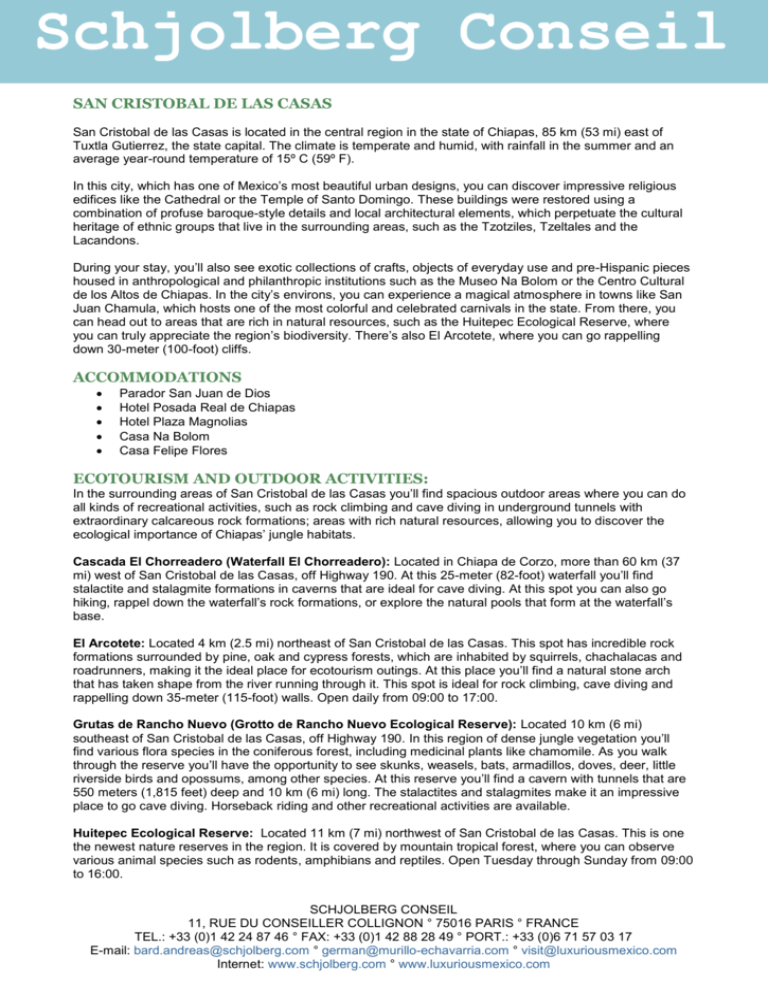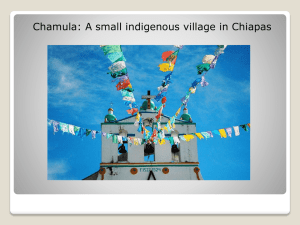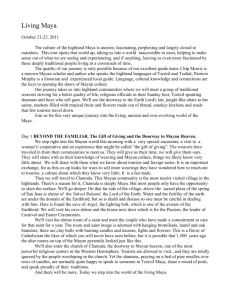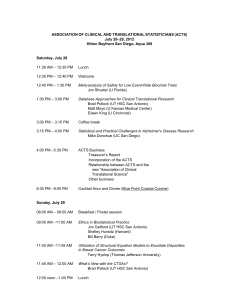Printer friendly version
advertisement

Schjolberg Conseil SAN CRISTOBAL DE LAS CASAS San Cristobal de las Casas is located in the central region in the state of Chiapas, 85 km (53 mi) east of Tuxtla Gutierrez, the state capital. The climate is temperate and humid, with rainfall in the summer and an average year-round temperature of 15º C (59º F). In this city, which has one of Mexico’s most beautiful urban designs, you can discover impressive religious edifices like the Cathedral or the Temple of Santo Domingo. These buildings were restored using a combination of profuse baroque-style details and local architectural elements, which perpetuate the cultural heritage of ethnic groups that live in the surrounding areas, such as the Tzotziles, Tzeltales and the Lacandons. During your stay, you’ll also see exotic collections of crafts, objects of everyday use and pre-Hispanic pieces housed in anthropological and philanthropic institutions such as the Museo Na Bolom or the Centro Cultural de los Altos de Chiapas. In the city’s environs, you can experience a magical atmosphere in towns like San Juan Chamula, which hosts one of the most colorful and celebrated carnivals in the state. From there, you can head out to areas that are rich in natural resources, such as the Huitepec Ecological Reserve, where you can truly appreciate the region’s biodiversity. There’s also El Arcotete, where you can go rappelling down 30-meter (100-foot) cliffs. ACCOMMODATIONS Parador San Juan de Dios Hotel Posada Real de Chiapas Hotel Plaza Magnolias Casa Na Bolom Casa Felipe Flores ECOTOURISM AND OUTDOOR ACTIVITIES: In the surrounding areas of San Cristobal de las Casas you’ll find spacious outdoor areas where you can do all kinds of recreational activities, such as rock climbing and cave diving in underground tunnels with extraordinary calcareous rock formations; areas with rich natural resources, allowing you to discover the ecological importance of Chiapas’ jungle habitats. Cascada El Chorreadero (Waterfall El Chorreadero): Located in Chiapa de Corzo, more than 60 km (37 mi) west of San Cristobal de las Casas, off Highway 190. At this 25-meter (82-foot) waterfall you’ll find stalactite and stalagmite formations in caverns that are ideal for cave diving. At this spot you can also go hiking, rappel down the waterfall’s rock formations, or explore the natural pools that form at the waterfall’s base. El Arcotete: Located 4 km (2.5 mi) northeast of San Cristobal de las Casas. This spot has incredible rock formations surrounded by pine, oak and cypress forests, which are inhabited by squirrels, chachalacas and roadrunners, making it the ideal place for ecotourism outings. At this place you’ll find a natural stone arch that has taken shape from the river running through it. This spot is ideal for rock climbing, cave diving and rappelling down 35-meter (115-foot) walls. Open daily from 09:00 to 17:00. Grutas de Rancho Nuevo (Grotto de Rancho Nuevo Ecological Reserve): Located 10 km (6 mi) southeast of San Cristobal de las Casas, off Highway 190. In this region of dense jungle vegetation you’ll find various flora species in the coniferous forest, including medicinal plants like chamomile. As you walk through the reserve you’ll have the opportunity to see skunks, weasels, bats, armadillos, doves, deer, little riverside birds and opossums, among other species. At this reserve you’ll find a cavern with tunnels that are 550 meters (1,815 feet) deep and 10 km (6 mi) long. The stalactites and stalagmites make it an impressive place to go cave diving. Horseback riding and other recreational activities are available. Huitepec Ecological Reserve: Located 11 km (7 mi) northwest of San Cristobal de las Casas. This is one the newest nature reserves in the region. It is covered by mountain tropical forest, where you can observe various animal species such as rodents, amphibians and reptiles. Open Tuesday through Sunday from 09:00 to 16:00. SCHJOLBERG CONSEIL 11, RUE DU CONSEILLER COLLIGNON ° 75016 PARIS ° FRANCE TEL.: +33 (0)1 42 24 87 46 ° FAX: +33 (0)1 42 88 28 49 ° PORT.: +33 (0)6 71 57 03 17 E-mail: bard.andreas@schjolberg.com ° german@murillo-echavarria.com ° visit@luxuriousmexico.com Internet: www.schjolberg.com ° www.luxuriousmexico.com Schjolberg Conseil ARCHEOLOGY: ARCHEOLOGICAL ZONE OF TONINÁ: Near San Cristobal de las Casas you will find one of the most important and best-preserved Mayan archaeological zones. It is reached by the Palenque-Ocosingo road, then continuing on a paved road for 11 km (7 miles) up to the site. Tonina means "House of Big Stones." It was a ceremonial center of the Mayan culture and reached its peak between the years 600 to 900 A.D. During the late classic, it had great military importance, testified by the abundant representation of prisoners in stucco and stone relief. Its most important governor was Tzots Choj, "Bat-Tiger." The Acropolis was built over natural rises of the land at the base of which is located a large plaza with an adjoining ball court, several temples, altars and steles over seven platforms. Among the most important edifices are: El Palacio de las Grecas (Palace of the Fretworks), El Palacio de la Guerra (Palace of War), El Templo de los Prisioneros (Temple of Prisoners) and El Templo del Espejo Humeante (Temple of the Smoking Mirror). There is also the Mural of the Four Suns, an impressive stucco relief representing four distinct eras of history. The visit is completed with the fabulous site museum. Open Tuesday through Sunday from 10:00 to 5:00. ATTRACTIONS AND HISTORIC ARCHITECTURE: In San Cristobal de las Casas you can admire picturesque houses with red tile roofs, beautiful cobblestone streets and the notable colonial-style architecture that reflects the city’s historical importance. Catedral de San Cristobal de las Casas (The Cathedral): Located north of Plaza 31 de Marzo. When the province of Chiapas was first raised to the level of a diocese, the modest Church of La Asuncion, which was begun in 1528, was converted into the Cathedral of St. Christopher the Martyr. Its first effective bishop was Frey Bartolome de las Casas. The primitive edifice was gradually replaced by the current construction that was begun in the 17th century and not finished until the 20th. The last restorations are from 1920, which is why they exhibit classicist details, such as the side portal, whose design was copied from Vignola's treatise. It seems that the main façade dates from the 18th century and falls within the Baroque style. Many are the treasures that the interior of the cathedral holds, like profuse mortar ornamentations and Solomonic altarpieces, deserving a careful visit. The pulpit is very interesting, one of the three most magnificent pulpits in the city. Open daily from 08:00 to 19:00. Parque Plaza Mayor 31 de Marzo (Main Plaza): Located in San Cristobal’s downtown area, between Real de Guadalupe and General Utrilla streets. This is the main square and in colonial times it functioned as the hub for all civic activities, such as the market and water supply, from the font located there. The indigenous people used to come to this plaza twice a year to pay tribute during the festivities of St. John and Christmas. Currently it is surrounded by the buildings of the civic and religious authorities and by the archway where the merchants sell their wares. Its kiosk dates from the early 20th century. Numerous artistic and cultural activities are held in the plaza’s pavilion. Temple y Ex Convent de Santo Domingo de Guzman: Located on Avenue 20 de Noviembre. This is one of the city’s most beautiful and emblematic buildings. The first stone for the church was placed in 1547 by Francisco Marroquin, Bishop of Guatemala. It seems that the current church dates from the 17th century, but elements predating this were undoubtedly used for its construction. The exterior has been modified apparently the façade was between two structures of which the southernmost is gone and there remain only some traces of it on the church wall. The façade is exquisitely decorated and on it a great Dominican coat-ofarms stands out. The mortared decoration, which covers the entire façade, deserves special attention. The motifs are unusual and make this façade one of the most ornate from Mexican and Central American colonial art. To find these motifs requires a minutely precise observation: There are anagrams, little angels, sirens and personages between lions. The Dominican House of Antigua, no longer standing, may have been its model. The pulpit is of remarkable beauty. Its structure rises upon a pedestal profusely carved in the likeness of a sumptuous golden challis. It is one of Mexico's best. Inside you’ll see motifs of indigenous design. Sure to grab your attention are a pair of two-headed eagles that flank the sculpture of Santo Domingo. Open daily from 08:00 to 19:00. Iglesia de la Merced (Church of Mercy) and Amber Museum: The Church of Mercy was the first convent established in San Cristobal and the Mercedarian Order arrived there in 1537. It was always a modest construction because the prestige of the Order was never significant. During the Porfirio Diaz government the church was remodel in neoclassic style with its characteristic turret, and the convent served as jail. In the sacristy a Roman arch from the original construction remained, decorated with flower motifs and a mortared relief of the sun and the moon held in place by a thick column. Among its paintings are a two-headed eagle SCHJOLBERG CONSEIL 11, RUE DU CONSEILLER COLLIGNON ° 75016 PARIS ° FRANCE TEL.: +33 (0)1 42 24 87 46 ° FAX: +33 (0)1 42 88 28 49 ° PORT.: +33 (0)6 71 57 03 17 E-mail: bard.andreas@schjolberg.com ° german@murillo-echavarria.com ° visit@luxuriousmexico.com Internet: www.schjolberg.com ° www.luxuriousmexico.com Schjolberg Conseil and the date 1759. In later times, the convent was turned into a municipal jail, and now holds the Museum of Amber, which exhibits exceptional pieces of that resin from Mesozoic trees. This amber was extracted from mines within the state, which, along with those in the Dominican Republic, are the only sources in America. Templo del Carmen (Church of Carmen): Located on the corner of Hermanos Dominguez and Avenue Miguel Hidalgo. Built during the 17th century, a chapel was later added during the 18th century, this building has its original façade and arched tower intact, which was constructed in the 18th century using a mudejarstyle design. There is nothing remaining of the old Conceptionist Convent of the Incarnation (as it was known during colonial times). The church with its "L" layout is in the corner of a small square. It has a single nave with a ceiling of wood and tiled roof with a principal arch that opens to the main chapel. After the flood of 1652 a different tower was added. The access is through the side that faces the square, as is common among churches and convents of New Spain. In 1993, a fire destroyed the treasures of El Carmen. The house next door is an excellent example of San Cristobal's domestic buildings. Today, it hosts the El Carmen Cultural Center. Church of San Nicholas: Built between 1613 and 1621, it is the only church in the city that conserves its primitive shape. The construction exhibits the mudejar style - the layout is in a single nave, with carved panels on the ceiling and covered with a double- sloping wood and tile roof. The simple façade is made of stone and brick and shows a polychrome patina typical of native architecture. It currently houses the Diocesan Museum, in back of the cathedral. Visits to the Museum are by appointment. Templo de La Caridad (Temple of the Charity): It belonged to the hospital and convent of the Order of San Juan de Dios, of which nothing remains. Its construction dates from 1712, the same year of the Tzeltal rebellion, to which it is intimately related, as its promoter was Fray Juan Bautista Alvarez de Toledo, bishop of Chiapa and Soconusco. This bishop was also indirectly responsible for the rebellion by demanding from the indigenous people substantial collections to raise funds for the construction of this temple, thereby affecting the already distressed economy of the communities. Church of San Francisco: Franciscan friars arrived in the royal city but could never compete with Dominican predominance. The Franciscan church was built from the 17th to the 18th centuries. It is built with one nave with carved panels on the ceiling. The façade is outstanding for its windows and the simple mortared decoration. The pedestals for the pilasters proceed from a Guatemalan model in vogue at those times in Antigua. Its pulpit is one of the three that comprise the premiere group of San Cristobal's pulpits. On the way to Santa Lucia via Insurgentes street, one of the best Neoclassic mansions is found at the corner of Hermanos Dominguez and the small square, where a monument to fray Bartholomew de las Casas was erected at the beginning of last century. Casa de la Sirena (House of the Mermaid): Located on the southern end of Plaza 31 de Marzo. This is an outstanding example of domestic colonial architecture still standing in the city. It is said that this house belonged to Andres de la Tovilla, one of the conquistadors, fellow-in-arms of Pedro Portocarrero and commissioner of Copanaguastla. The façade of the house is reminiscent of the plateresque style. It was probably built during the 16th century with brick and mortar in very ingenious designs. The door has a coatof-arms and ornate columns crowned with lions on both sides; the topmost window is between a pair of twoheaded eagles; another window is decorated with mortared mermaids and a snake-woman. The name of the house comes from a rough stone mermaid in the corner of the building facing the plaza. Municipal Palace: Its first stone was laid in 1885 to replace the building burned down by the rebel troops of Juan Ortega in 1863, during the struggle between the Republicans and the Imperialists. The original intention was to make a building that would fill the entire block and would be the seat of the state government, but when the city lost its capital status, only a quarter of it was completed. It is the best example of the Neoclassic style that was introduced by Carlos Z. Flores to San Cristobal after a delay of more than a century from the time it appeared in Guatemala and other parts of Mexico. Flores probably had a copy of Vignola's architectural treatise from the 16th century that was circulated in an 1858 edition. The design he drew up for the palace was an almost exact copy of one of the illustrations from that treatise, which, although Neoclassic, maintained the traditional use of the covered archway as can be seen in other older Central American government buildings. Public Market: Located six blocks to the north of Plaza 31 de Marzo, along General Miguel Utrilla Avenue, it is a very interesting place where members of all the surrounding indigenous communities converge. SCHJOLBERG CONSEIL 11, RUE DU CONSEILLER COLLIGNON ° 75016 PARIS ° FRANCE TEL.: +33 (0)1 42 24 87 46 ° FAX: +33 (0)1 42 88 28 49 ° PORT.: +33 (0)6 71 57 03 17 E-mail: bard.andreas@schjolberg.com ° german@murillo-echavarria.com ° visit@luxuriousmexico.com Internet: www.schjolberg.com ° www.luxuriousmexico.com Schjolberg Conseil ARTS AND CRAFTS: In San Cristobal de las Casas you can buy quality handicrafts, including beautiful wool garments, textiles and embroidered items. In some of the neighborhoods, such as El Carrillo and La Merced, you’ll find forged steel objects, wax sculptures and silver and amber jewelry. A good place to purchase crafts is the Casa de Artesanias (Crafts House) on Avenue Hidalgo. Crafts: Crafts are all the manifestations that people have produced through the ages and are present every moment because they are the root of our cultural identity. In Chiapas various craft skills based on an antique PreHispanic tradition continue to be used for production. Textiles: In this region outstanding textiles for ceremonial use and for everyday life are made of wool or cotton, and they are unique to every location and town in which they are produced. All are woven in a back-strap loom, and adorned with brocades and embroidery. Codices and other documents indicate the type of garments used in pre-Hispanic times, the earliest findings of which show ancient apparel from about 1500 B.C. The apparel of the Tzozil and Tzetzal indigenous people from the Chiapas Highlands varies with each group, and is produced with different techniques, materials and designs that identify and differentiate them. Apparel is a symbol of identity and of belonging to a certain ethnic group. Clothing is an artistic and cultural statement indicating the different positions and offices that an indigenous person performs within his community. The materials used are cotton and hairs or feathers from different animals, although in the 15th century, the Spaniards introduced wool and silk as well as the foot-pedal loom which did not and has not, replaced the back-strap loom. Within the range of these textiles the most outstanding are the open-work (deshilado) embroidery (bordado) and the woven-in brocades used in garments or tablecloths that preserve elements of the indigenous decorations passed from generation to generation. All the textiles are made with a back-strap loom, a very unique pre-Hispanic instrument, similar to a handmade frame with wooden sticks in which a web of base or woof threads are strung; the warp threads are then dexterously interwoven with a comb, creating the brocade. The white linen cloth for skirts and huipiles (shirts) are also made with cotton thread in the back-strap loom. Huipil Garments of Magdalenas: In this small Tzotzil community within the municipality of San Andres Larrainzar, 25 km (15.6 miles) northeast of San Cristobal de Las Casas, the huipiles are true works of art, similar to oriental tapestries. They are made on back-strap looms with cotton or wool threads tinted with natural dyes, creating beautiful rhombic brocades on the front, back and sleeves. The time necessary to create them ranges from 8 to 10 months. It is here where the ritualistic and symbolic comes into play in these garments that reflect the world of ritual, magic and ceremony, and where we find elements of luxury. It is here in Magdalena that it is an honor for a woman to make a ceremonial huipil for a virgin, whether as a gift or use by the wife of the village steward. The entire process of making the huipil is a ritual of blessing the threads and the combs; the virgin will be in touch with the consciousness of the weaver, through her fingertips, so she doesn't make any errors in this important job she is going to perform. The garments used to dress the statues of the saints and the huipiles (ritual textiles) of the virgins are kept in the "bulto" (bundle) or "tilma" (linen sheets that cover the shoulders and are also used to distinguish among those who have already performed a service to the community or carried the "bulto"). The "bearer of the bulto" is designated for this duty for one year and is also the custodian of the ritual objects (loom, spindle etc.). The current village steward safeguards these objects, in order present them to the saints, previously perfumed with incense, and they are used to beautify the processions of those celestial images. Woodworking: The manufacture of popular toys as a household objects and products for is often inspired by attitudes and circumstances in everyday life. They are made of various materials such as clay, wood, tin, natural fibers, cardboard and paper. But in San Cristobal de Las Casas, woodworking predominates, and the toys are exemplary of the elaborate work that the craftsmen produce with great mastery, from furniture to kitchen utensils and musical instruments. SCHJOLBERG CONSEIL 11, RUE DU CONSEILLER COLLIGNON ° 75016 PARIS ° FRANCE TEL.: +33 (0)1 42 24 87 46 ° FAX: +33 (0)1 42 88 28 49 ° PORT.: +33 (0)6 71 57 03 17 E-mail: bard.andreas@schjolberg.com ° german@murillo-echavarria.com ° visit@luxuriousmexico.com Internet: www.schjolberg.com ° www.luxuriousmexico.com Schjolberg Conseil Boxes and coffers are made from split wood colorfully painted by hand with flower motifs on a pink background, and are also used to elegantly present the regional candies of cajeta de membrillo (quince jelly) and camote (candied yam). With the introduction of the wood lathe, a variety of toys are now being manufactured, such as a spinning tops and games as "baleros," "maromero," "trepatemicos," and birds on wheels propelled with a stick, fighting cocks, trucks and an endless number of typical toys made by the craftsmen of Guadalupe district, where throughout the streets are stores and booths full of colorful crafts. On Holy Saturday the popular Judas figures are always evidence during the traditional Burning of Judas night, when giant puppets representing funny and wicked famous political figures come out. At Christmastime, the famous piñatas are displayed filled with the seasonal fruits, brightening the traditional "posada" parties. Metalwork: Wrought iron (Decorative and utilitarian): This is the technique of transforming metals into objects and instruments for daily use and decoration. This metal craft was brought by the Spaniards and there are two primary techniques: forging and hammering. Forging requires an open pit fire and bellows to heat the metal making it malleable, and then it is shaped with the hammer blows. Colonial-style wrought iron works are very fashionable in the construction industry, used for balconies, window grates, benches, street lights and lamps etc., and it is in the El Cerrillo District of San Cristobal de Las Casas where doors, knockers, windows, lamps and chandeliers and the typical "Cruces de Pasión" (Crosses of the Passion) are forged in different sizes, styles, shapes and figures in which each craftsman imprints his own personal design. During the colonial period, these crosses, representing the Passion of Christ with all their figures, were set on the roofs of houses as a protection against evil and as an emblem of faith. Currently they are sold to collectors as decorations to embellish the corridors of old mansions transformed into hotels with colonial charm. Waxworks (Candles): Candles made out of wax or paraffin have become indispensable elements in rites and religious ceremonies. They are also made for decorative purposes, to embellish tables or chandeliers. Exquisitely beautiful works of wax art can be found in the La Merced District. The artisans' hands transform the paraffin into subtle flowers with delicate leaves, sprinkled with gold dust, adorning temples and altars or beautifying processions of virgins and saints through the city's plazas and streets. Saddlery: This craft, of Spanish precedents, is still practiced in San Cristobal de Las Casas. It consists of the elaboration of various objects from leather or animal skin, which is engraved and hammered. First the leather goes through the tannery process to preserve it and make it pliable, and then it is transformed into handsome wallets, belts, bags, portfolios, suitcases, caps, hats etc. in various sizes and designs according to each craftsman's taste. Of great importance also is the riding saddle and other articles used in the "charro" (Mexican rodeo), which take place in La Frailesca District. The participants of the charro come here to order or buy these products. Tinwork: Tinwork is a craft inherited from Spain. It is a simple technique compared with other metal works; its tools are not complicated, being mainly shears to cut the thin sheets of tin, scissors, punches, chisels and soldering tools. At the municipal market in San Cristobal it is common to find useful tinwork pieces such as chandeliers, strainers, funnels, heating plates, oil lamps, mirrors, trays etc. where the intended use is practical more than ornamental and its price accessible. Silversmith and Sculpture with Amber and Jade: Amber is a fossil resin that dates back 40 million years, of predominantly yellow color, hard, brittle, translucent, warm to the touch and aromatic. Amber takes us back to ancient cultures where it had a ritualistic and magic role as a charm for children against the "evil eye" and bearer of good luck. SCHJOLBERG CONSEIL 11, RUE DU CONSEILLER COLLIGNON ° 75016 PARIS ° FRANCE TEL.: +33 (0)1 42 24 87 46 ° FAX: +33 (0)1 42 88 28 49 ° PORT.: +33 (0)6 71 57 03 17 E-mail: bard.andreas@schjolberg.com ° german@murillo-echavarria.com ° visit@luxuriousmexico.com Internet: www.schjolberg.com ° www.luxuriousmexico.com Schjolberg Conseil In the mines at Totolapa and Simojobel this resin is extracted, which after being polished becomes a jewel, unique because of its shape, color, and composition. Its market value depends on its size, color or the number of insects or plants trapped inside. With an appropriate polish it can be made into beads for earrings or necklaces, rings, clasps, bracelets etc. Some jewelry pieces show the typical yellow color but there are others outstanding for their reddish, green or blue tones which, combined with silver or gold, result in exquisite works from San Cristobal's silversmiths. Amber is an ideal material for sculpture and in San Cristobal there are extraordinary sculptors who create true art works of art. Since pre-Hispanic times, jade has been regarded as an exquisite stone of great value and symbol of economic power. Among the Aztecs it was know as "chalchihuite." Jade is a mineral formed in the earth's crust some 400 million years ago. In Chiapas there are deposits in the municipality of Chalchihuitan ("Land of Jade") about 50 km (31 miles) to the northeast of San Cristobal de Las Casas. Because of its hardness, it can only be worked with industrial diamond tools, and can be given a shiny or matt finish. Recycled Paper (Taller Leñateros): The Taller de Leñateros was founded in San Cristobal more than 20 years ago and is a Cooperative Crafts Union composed of men and women of indigenous or mixed descent, who produce handmade paper from the raw materials of several species of flowers, grasses, lichens, banana trees, bark, bamboo and diverse clothes. In addition to producing paper, they print books, serigraphs, and wood engravings, and edit the periodical "La Jicara" a true work of art that, in the form of pictographic codes, presents the best of original contemporary literature, stories, songs and traditions. It contains original engravings, with each number presenting novel and creative ideas. Guided tours and courses are offered, about the use of plants and how to extract dyes from them in order to make paper. The Taller is located at Flavio A. Paniagua street, number 54 in the El Cerrillo District. Fiber Accoutrements: "Jarcería" is a weaving technique done with any natural fiber or soft bark of vegetable origin such as rattan, palm, straw and several types of grass used in the creation of decorative or utilitarian objects for daily life such as hammocks, nets, mats, hats, handbags and rope. The artistic value of these fiber accoutrements depends on the design and the craftsman's aptitude. Unlike typical baskets, which are woven uniformly, these handcrafted products are fabricated with the fibers slightly turned in a spiral to give shape to the ropes or cords and in many cases the fibers are tinted with natural dyes. At San Cristobal's municipal market and along Real de Guadalupe Street you a great variety of these products are offered for sale, priced according to their design, style, shape, color and size. Basket-Weaving: The abundance of natural fibers such as palm in Chiapas has given rise to one of the oldest handcrafts, basket-weaving. Basket-weaving can be defined as a series of techniques by which relatively hard elements are woven to produce containers and flat objects. Vegetable fibers are mostly woven by hand, although sometimes a sharp tool is used to tighten the weaving and a knife is used to cut the material. Other times a needle is used to bind together different sections of the weaving. In general, craftsmen use both hands and feet to weave and some times even the teeth are used to tighten and bend the fiber. In San Juan Chamula, two different materials are used in basketry, bamboo for the weaving and sticks from a thorny plant called "mecate" used for framing the basket. In Zinacantan and Tenejapa palm hats decorated with ribbon are woven. The time to produce them is about seven weeks and they are hand stitched. Various utilitarian items include baskets, panniers, mats, rugs, etc. Because they are lightweight, woven containers can be used to transport food and other types of products. Related to these products are the fiber accoutrements. FESTIVALS AND TRADITIONS: San Cristobal’s main religious celebrations take place during Holy Week, when you can witness the traditional Viacrucis procession and attend a fair held to mark the beginning of Easter. In November and December, the city hosts the Antorcha Guadalupana race, which draws young pilgrims who travel in groups to Mexico City, Oaxaca or Guatemala and then return to San Cristobal running with a lit torch to celebrate the Virgin of Guadalupe on Dec. 12. Another important festivity that takes place in San Cristobal’s surrounding areas is the Carnival of San Juan Chamula, which is held in February and March. During this SCHJOLBERG CONSEIL 11, RUE DU CONSEILLER COLLIGNON ° 75016 PARIS ° FRANCE TEL.: +33 (0)1 42 24 87 46 ° FAX: +33 (0)1 42 88 28 49 ° PORT.: +33 (0)6 71 57 03 17 E-mail: bard.andreas@schjolberg.com ° german@murillo-echavarria.com ° visit@luxuriousmexico.com Internet: www.schjolberg.com ° www.luxuriousmexico.com Schjolberg Conseil celebration you’ll see parades, Mass ceremonies and cleansing rituals, such as people walking over hot coals. January 1, New Year's Festivities, celebration of Masses, parades and fireworks. Holy Week (March or April), processions, celebration of Masses throughout the state. In some towns, the Burning of Judas ritual takes place - represented by paper-maché figures and cartoons of historical or contemporary personalities. Feria de la Primavera y de la Paz (Seven days after Sunday Easter), with different social and cultural events, parades and sport events. July 17-25 celebration honoring the city's patron saint St. Christopher the Martyr with masses and parades. September 16 is National Independence Day, celebrated with the Mayor presiding over the traditional ceremony of "El Grito" (the Shout for Independence). November 1 and 2 are All Saints Day and Day of the Dead. Offerings are placed at the graves of the deceased to welcome and summon their souls, which are believed to return during these days. The offerings include traditional meals placed on altars inside the houses along with candles and flowers, or at the graves where families spend the day praying. December 12 is the festival of the Patron Saint of all Mexico, the Virgin of Guadalupe celebrated with Mass, serenades and pilgrimages. GASTRONOMY: In San Cristobal you can try exquisite dishes of indigenous and Spanish influences. Among the regional fare you can enjoy are tamales with chipilin leaves, chalupas, chiles stuffed with pork or vegetables and the delicious asado chiapaneco (a roasted pork dish). You can also enjoy pork, beef and vegetable stews, bread soup, beef tongue in saffron and Soconusco-style chanfaina (lamb organs served with rice). To accompany your meal, order a refreshing glass of punch or a tascalate (a fermented corn beverage). MUSEUMS: In San Cristobal de las Casas you can visit interesting museums where you’ll see exhibits of regional culture and history. Mayan Medicine Museum: In 1997, the Museum of Mayan Medicine received the National Museum Prize “Miguel Covarrubias”, given by the National Institute of Anthropology and History. The Museum’s primary objective is spreading information about Tzotzil and Tzeltal curative practices on regional, national and international levels. The Museum consists of several museographic environments depicting the traditional Mayan practices and therapeutic resources of the indigenous physicians of Chiapas. The museum possesses six exhibit spaces and a demonstrative garden containing many important medicinal plants. If you have health problems, you may want to try the herbal pharmacy. Or, you may visit a traditional doctor (pulsador) in the church of the museum, who may diagnose your condition by reading your pulse, or perform a ritual to heal body and soul, using prayer or the temazcal (traditional steam bath). The Museum is open from Monday to Friday, from 10:00 to 18:00 and Saturday and Sunday: from 10:00 to 17:00. The Mayan Medicine Museum is located at the Center for the Development of Mayan Medicine (CEDEMM). For further information please visit: www.medicinamaya.org. Centro Cultural Museo de los Altos de Chiapas (The Cultural Center of the Highlands): Located in the old Convent of Santo Domingo, on Av. 20 de Noviembre. Inside the old Dominican convent is the Cultural Center of the Highlands; in it is a large room with depictions of the history of the city of San Cristobal, showing the main events through the years. Among its pieces are some silver petals from the pomegranate receptacle that held the Host at the cathedral, which was the most important silversmith work from Chiapas, and the bishop's cathedra, the main piece from the lost choir stalls of the cathedral. Here you can visit the Sna Jolobil (House of Weaving in the Tzotzil language) crafts store, showing textiles with pre-Colombian designs exemplifying the Mayan cosmological vision. Open Tuesday through Sunday from 10:00 to 17:00. Museo Na Bolom, Casa del Jaguar (Na-Bolom House of the Jaguar Museum): Located at 33 Av. Vicente Guerrero, on the corner of Calzada Frans Blom. This museum was founded by famed Danish anthropologist and philanthropist Frans Blom and his wife Gertrude Blom, who left behind a collection of archaeological pieces, crafts and regional Mayan objects. The house is decorated with regional crafts, exhibiting Mayan ceramics and everyday objects of the Lacandons (inhabitants of the Lacandon jungle) in SCHJOLBERG CONSEIL 11, RUE DU CONSEILLER COLLIGNON ° 75016 PARIS ° FRANCE TEL.: +33 (0)1 42 24 87 46 ° FAX: +33 (0)1 42 88 28 49 ° PORT.: +33 (0)6 71 57 03 17 E-mail: bard.andreas@schjolberg.com ° german@murillo-echavarria.com ° visit@luxuriousmexico.com Internet: www.schjolberg.com ° www.luxuriousmexico.com Schjolberg Conseil one of its halls. Another hall is devoted to the archaeological zone of Moxviquil, and yet another displays traditional textiles. Also here is the "Fray Bartolome de las Casas" library with over 10,000 volumes on history, culture and regional anthropology. The museum has an archive of journals, an audio archive, a chapel with religious art and a temporary exhibition space. At the back of the house is a Botanical Garden. Open daily from 10:00 to 17:00. Amber Museum: Housed in the old Convent de la Merced. The museum exhibits exceptional pieces of that resin from Mesozoic trees. This amber was extracted from mines within the state, which, along with those in the Dominican Republic, are the only sources in America. The Museum is open Monday to Sunday from 10:00 to 14:00 and from 17:00 to 20: 00 hours. The House of Jade (La Casa del Jade): Located in the historic downtown district of in San Cristobal. It contains an archaeological exhibit of sculptures and other pieces from the Mocaya culture, which developed in Chiapas before the Olmecs or the Mayas. It also has an extensive end exquisite collection of unusually colored jade pieces, from white to the darkest almost black, passing through the shades of pinks and shades of purple. The House of Jade guarantees the authenticity of its products. The most spectacular exhibit of The House of Jade is the sepulcher of Pakal, the eleventh governor of Palenque. This mausoleum shows an excellent reproduction of the grave of this king, who was interred wearing a jade mask and other adornments under the Temple of the Inscriptions. The House of Jade is located on 16 de Septiembre Street. Guided tours are offered everyday at noon and at 21:00 hrs. Centro Cultural del Carmen: Three blocks away from Plaza 31 de Mayo along Hidalgo Avenue, there is a series of old and new buildings that form this architectural unit. Among them are the Public Library, The Convention Center and the Arts Building. Museo Sergio Castro e Hijos: Located at 47 Guadalupe Victoria Street. This museum has an extensive collection of objects and garments related to the textile works of the Tzotziles, Tojolabales and Lacandones. It also house old musical instruments. Open Tuesday through Sunday from 10:00 to 17:00. SHOPPING: If you’d like to go shopping, we recommend that you visit the outdoor crafts and textile market next to the Cathedral, or the Casa de Artesanias on Av. Hidalgo. You can also visit the Jose Castillo Tielemans market, located on the corner of Av. General Utrilla and Diaz Ordaz. Other places to buy souvenirs are the pottery and basketwork shops that you’ll find on Real de Guadalupe Street. ENTERTAINMENT AND SPORTS EVENTS: In San Cristobal de las Casas you’ll find a special venue that stages numerous artistic and cultural events. Centro de Convenciones El Carmen (Conventions Center El Carmen): Located on the corner of Hermanos Dominguez and Miguel Hidalgo, in the downtown area. This is the most important cultural venue in the city. It can hold 1,000 spectators. NIGHTLIFE: San Cristobal de las Casas is a quiet city, yet it has various places where you can enjoy a night out, including bohemian bars that receive visitors from all over the world. It also offers excellent discos, live music and restaurants serving local and international fare. For prices, reservations, availability and bookings, please contact us at: visit@luxuriousmexico.com SCHJOLBERG CONSEIL 11, RUE DU CONSEILLER COLLIGNON ° 75016 PARIS ° FRANCE TEL.: +33 (0)1 42 24 87 46 ° FAX: +33 (0)1 42 88 28 49 ° PORT.: +33 (0)6 71 57 03 17 E-mail: bard.andreas@schjolberg.com ° german@murillo-echavarria.com ° visit@luxuriousmexico.com Internet: www.schjolberg.com ° www.luxuriousmexico.com







